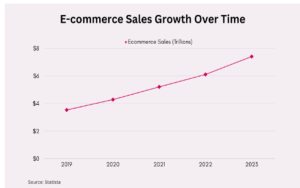Introduction
Efficient product delivery is crucial now more than ever. E-commerce sales continue to soar. Customer expectations of faster fulfillment are rising. Businesses are increasingly adopting advanced scheduling solutions. This way, they can enhance their supply chain and delivery operations.
This article will explore the following subtopics:
- Evolution of product delivery
- The growing need for improved efficiency
- How advanced scheduling software with features is transforming traditional systems
We will also showcase innovative companies that are at the forefront of these advancements. We will discuss the tangible benefits achievable, and provide actionable recommendations for implementation. We will also delve into the essential role of solutions that focus on optimizing dock scheduling, especially considering the increasing volumes and pressure on warehouse operations. This is natural given the rising volumes and pressure on warehouse operations.
The Evolution of Product Delivery
Product delivery is the process of transporting goods from one location to another. This system has been in place as early as the 1600s. The process has been changing and evolving to this day. Product delivery ranged from homing pigeons to the current system involving trucks, ships, drones, and more. Technology greatly influenced this change and it will continue to do so in the future.
Physical goods are referred to as cargo. It is usually delivered through railroads, shipping lanes, and airlines. The delivery process is also called the distribution process. It goes hand-in-hand with logistics. Postal and courier services deliver them for commercial and private purposes. As such, they play a big role in the evolution of product delivery.
Product delivery methods have changed with the onset of emerging technologies. Shifting consumer preferences is another factor. It has become increasingly oriented towards convenience and speed.
The Need for Advanced Scheduling Solutions
Scheduling is more than a simple logistical necessity. It is a strategic element that dictates the success or failure of a supply chain. The limitations of traditional scheduling tools present significant challenges that logisticians must overcome. These struggles often result in delays, cost overruns, and contractual penalties. As such, scheduling logistics software makes the job easier and streamlined. It fundamentally transforms the industry and its workflow.
The situation is compounded by the exponential growth of e-commerce sales over the years. It is projected to account for over 21% of total retail spending in the next two years. As such, the pressure on efficient delivery services has never been higher.

Advanced Scheduling Solutions: Key Components
Cutting-edge scheduling systems utilize extensive data and robust algorithms. This technology enables intelligent optimization of delivery operations. Core capabilities and components include:
Real-Time Tracking and Monitoring
Integrates live data from sensors and GPS tracking to provide 24/7 visibility into delivery fleet location. Users also have visibility of its status, inventory, equipment vitals, and more. This granular data fuels advanced analytics. At the same time, it also eases rapid contingency adjustments by dispatchers to reduce delays.
Route Optimization Algorithms
Processes vast amounts of historical and real-time data on the following and more:
- Traffic
- Weather conditions
- Road infrastructure
- Fuel costs
- Labor hours
- Vehicle capacity
Demand projections
It generates suggested routes and delivery sequences that balance priorities. Examples of those are the following:
- Lowest mileage
- Fastest ETAs
- Cost efficiency
- Sustainability
- Highest driver productivity
These algorithms dynamically adjust recommendations based on real-time developments.
Inventory Integration
Ties into warehouse systems and inventory data to consider the following:
- Product availability
- Priority shipments
- Storage constraints
It is especially helpful when generating delivery schedules and truck loading recommendations. It can reduce split loads and optimize space use while fulfilling business objectives.
Dock Scheduling Modules
Specific capabilities tailored to optimizing the warehouse yard, dock, and on-site delivery operations. They provide granular analysis on dock capacity versus demand. These modules calculate dock assignments and prioritize truck sequencing. That way, they can smooth traffic flow and prevent congestion, driver detention, and bottlenecks. Facilitates just-in-time movements.
Driver Mobility Applications
Provides drivers with turn-by-turn guidance based on:
- The latest planned routes
- GPS tracking
- Proof-of-delivery functionality
- Access to inventory details
- Chat options with dispatch
- More right on their mobile devices for greater productivity while in the field
The Benefits of Advanced Scheduling Solutions
Companies that harness advanced scheduling systems have witnessed transformations that yield compelling benefits:
Improved Customer Satisfaction
Enhance delivery speed and precision to meet quoted ETAs and reduce missed attempts. Customer satisfaction metrics see over 35% average improvements.
Increased Delivery Productivity
Optimized routes, dock operations, and inventory readiness combine. Together, they drive an average of 11% faster delivery times after adoption.
Lower Fuel and Labor Costs
Reduced mileage from route optimization and elimination of wait times and bottlenecks. These drive average fuel savings of 29% annually. The combined labor cost savings resulting from productivity improvements exceed 20%.
Greater Visibility and Control
The comprehensive real-time visibility facilitated by these systems equip businesses with greater agility. Dispatchers gain the ability to proactively intervene to prevent exceptions.
Sustainability Gains
Optimized routing and capacity use inherent in advanced algorithms promote sustainability. It reduces miles driven and emissions. EVs can further amplify environmental gains.
Enhanced Performance Management
Rich operational data powers actionable insights into delivery KPIs for continuous optimization efforts. At the same time, connectivity platforms like driver apps maintain high standards.
There is mounting pressure on delivery efficiency and increasing consumer expectations. Thus, forward-thinking businesses are leveraging these solutions to drive strategic advantages. The results clearly demonstrate their transformative potential.
Addressing Challenges
Barriers like change resistance among drivers or integrations with legacy systems may exist. But the long-term benefits far outweigh the growing risks of inefficient delivery systems. Strategic planning and beginning with pilot deployments can help mitigate common obstacles during the transition.
Future Trends and Innovations
The next frontiers of innovation include the use of machine learning to enable the following:
- Automated self-optimization of systems
- Augmented reality wearables that provide drivers with real-time guidance
- Electric vehicles with enhanced range and sustainability
Frequently Asked Questions (FAQs)
How can scheduling software improve last-mile delivery challenges?
Sophisticated algorithms can plan sequences and implement contingency rerouting to avoid delays by considering:
- Live traffic
- Weather data
- Historical route metrics
What results have companies observed after investing in this technology?
On average, companies using advanced scheduling solutions report the following:
- 11% faster delivery times
- 29% lower fuel costs and labor hours
- Over 35% improvements in customer satisfaction metrics
Conclusion
The landscape of delivery continues to evolve rapidly. Businesses must adapt their scheduling and fulfillment systems or get left behind. The innovation brought by advanced solutions heralds a new era of streamlined operations. Sustainability and customer-centricity are sure to shine as well. These changes will manifest in the company’s enhanced productivity, visibility, and agility. Now is the time for action. Learn more about deploying delivery optimization technology today.

